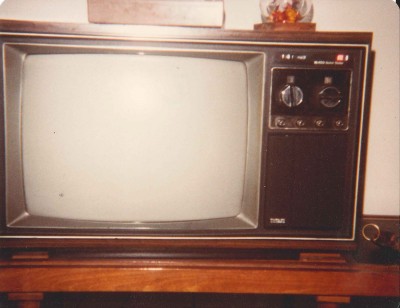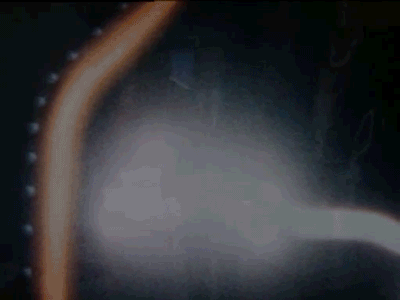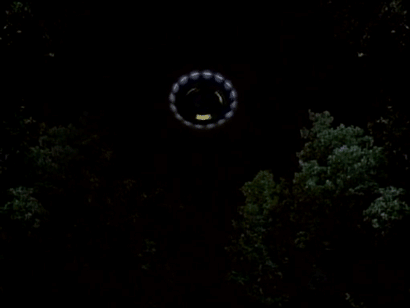
When I was young, Robert Stack would visit me in my dreams. His monotone voice and sharp eyes would come through my wood-paneled RCA cathode-ray childhood TV and settle in my subconscious until I went to sleep. During the day Unsolved Mysteries was an opportunity to, “solve a mystery” from the comfort of my own home. If I watched the dramatizations closely enough I thought I might recall some repressed memory of an alien abduction or I might notice a telltale tattoo that marks the new neighbor as a relocated serial killer. Solving these Lifetime-disseminated mysteries was a sacred trust that I did not take lightly. Everything from persistent hauntings to serial killings were on my plate. When you grow up in South Florida, extra terrestrial abduction and friendly serial killers seem so plausible. If we were able to fit over a million people on a sandbar and intoxicate them long enough to stay through hurricane season, anything could happen. But no matter how much I investigated I always seemed to disappoint Robert. My neighbor with eight fingers that loved ham radio was not the man suspected of murdering two teenagers in Ohio; he was just really racist. The lady across the street was not a reoccurring spectral phenomena; she was just 90 years old. None of these people were particularly extraordinary —let alone extraterrestrial— but Unsolved Mysteries injected a sense of the enchanted in an otherwise mundane suburban landscape.

Night however, was different. In my dreams these aliens, ghosts and murders came out to greet me. There was the reoccurring nightmare of the knife-wielding murderer hiding in the gardenia bushes in front of my house. His body almost completely obscured in darkness except his grizzly hand and that impossibly shiny blade. There was the snowy TV flickering in the dark room and the violent shadows that would attack me with rotting body parts covered in acid. In one dream there was a lonely TV on the floor in a smoky, dark room and it would flash static and snow while Robert Stack’s booming voice asked all the leading questions to which I had no answers: “Were these random occurrences? Or was this incontrovertible evidence of paranormal activity?” “Where has Mr. Dufresne gone and what happened to his blue Chevy Tahoe?” I wasn’t haunted by ghosts, I was haunted by the possibility of ghosts. Haunted that someone, somewhere was sending a manila envelope to a PO Box in Burbank, California with proof of alien abductions or poltergeists. It was only a matter of time, it seemed, before the aliens, ghosts, and murders found me and I would be called upon to testify-via-dramatization in front of an entire nation of daytime TV peers. But that time never came and for a while I thought that might be just as mysterious. Am I immune to spectral violence? What does it mean to never live a life worthy of reporting to a daytime TV producer?

My Unsolved Mysteries unconscious headcanon was terrifying, at times rising to the level of night terrors, but I wouldn’t trade it for the world. Magic doesn’t need to be beautiful to be personally meaningful. My fiancé and I talked about Robert Stack’s haunting voice on our first date. I imagine we’re not the only ones to bond over that childhood experience.There’s something grotesquely beautiful about those mental roller coaster rides that come to us in the night.
The show made genre-defying leaps of the TV dial fueled by its own widespread appeal: It went from primetime NBC to CBS before leaping to Lifetime and finally passing on to the afterlife of SpikeTV where it was hosted by someone that wasn’t the reanimated corpse of Robert Stack so who really cares? And yet since 2010 when the show was mercifully canceled, reruns have been infamously difficult to acquire. Can I Stream It? feigns ignorance and suggests some shitty one-off documentary from 2010. The episodes uploaded to YouTube have all been taken down. All that’s left now are a handful of re-edited themed DVD box sets that turn my daily paranormal briefings into some kind of too-long Discovery Channel documentary. The shows that made the paranormal seem mundane, are lost. A few years ago, in a fit of morose nostalgia, I searched Pirate Bay for remnants of Unsolved Mysteries and found very little: anemic seed counts of three or four active users sharing a smattering of low-res DVD rips. Its like we all gave up on all those mysteries.
The turn of the century also saw the death of the X-Files, another show that sought to reveal hidden mysteries albeit in a very different genre. Whereas Unsolved Mysteries made dramatic reenactments of unexplainable events, the X-Files offered us a peek behind the “no comment” curtain. It’s almost as though, if you slowed down an Unsolved Mysteries reenactment, you might find Mulder & Scully running in the background. Pirate Bay user Lucy1948 noticed as much and put it in her “read me” notes for “The UFO Files” download:
The UFO Files ? though Unsolved Mysteries has endured since 1987, the producers were savvy enough to update the show making sure that UFO segments had an X-Files-esque feel to them. Robert Stack, clad in a trademark trench coat, introduces each segment with semi-serious gravity, as if he were revealing a government secret to Mulder and Sculley. [Sic]
Unsolved Mysteries and The X-Files take place in the same universe, but approach it from radically different genres. They both instill a sense of the mystic in an otherwise thoroughly modern world. Its worth noting that many X-Files episodes are based on the same source material that made it on to Unsolved Mysteries. The Taos Hum, for example, was featured in both shows, along with references to the same crop circles and alien abduction scenarios. Vince Gillian had even gone so far as to write an Unsolved Mysteries / The X-Files crossover episode but it was never produced. They are entertaining because they give us the possibility of an enchanted world but never completely deny us the security blanket of rational science. This tension arises from what German sociologist Max Weber called “disenchantment.” All modern societies, according to Weber, replace mysticism and story telling as the predominant mode of explaining everyday events, with rational argument and empirical observation. Everything is explainable, so long as it is exposed to enough of Scully’s skepticism. It also meant that certain subjects were considered the domain of the natural sciences while others were a matter of society, culture, and politics.
 Shapin and Schaffer catalogued this separation in their well-known book Leviathan and the Air-Pump by studying the debates between Robert Boyle and Thomas Hobbes over Boyle’s revolutionary air pump demonstrations. It was the first time that scientific observation staked its claim as a legitimate source of truth outside of political power. Peer review (or, at least its primordial ancestor) of observable experiments, according to Boyle, was a better way of understanding the physical universe than the natural philosophy that could include concepts of morality or ethics alongside generalized observations. Whereas natural philosophy sought to place observable phenomena within larger schemas, experimental science used observable phenomena to build theories.
Shapin and Schaffer catalogued this separation in their well-known book Leviathan and the Air-Pump by studying the debates between Robert Boyle and Thomas Hobbes over Boyle’s revolutionary air pump demonstrations. It was the first time that scientific observation staked its claim as a legitimate source of truth outside of political power. Peer review (or, at least its primordial ancestor) of observable experiments, according to Boyle, was a better way of understanding the physical universe than the natural philosophy that could include concepts of morality or ethics alongside generalized observations. Whereas natural philosophy sought to place observable phenomena within larger schemas, experimental science used observable phenomena to build theories.
I don’t think Unsolved Mysteries orThe X-Files would make sense to us, let alone be entertaining or haunting, if Weber were correct. Even if the mysteries were meant to be solved and the truth was “out there” the whole point was to dwell in those precious moments before disenchantment and the inevitable ambiguity of the final act. Mulder The Believer and Scully The Skeptic might only exist in the modern dualism of nature and society, but they exist as foils who ultimately find the truth to be somewhere in-between their polar standpoints. That’s why I agree with Bruno Latour’s (in?)famous titular argument: We Have Never Been Modern. Latour argues that the rhetorical (and only rhetorical) siloing of nature and society has stunted work in both fields and a more interconnected analysis of human and nonhuman actors is necessary. The implicit upshot of collapsing the the nature / society divide is an enchanted world. Not a reenchanted world as some have argued but the same world full of specters and extraterrestrials that we always had. The X-Files and Unsolved Mysteries weren’t making these stories from whole cloth. They told modern myths in a way that they need to be told: in the parlance of science and skepticism.
It seems strange then, that in a world where we have exponentially increased any given individuals’ ability to record, document, and share their experiences, that we seem to have given up on these mysteries and x-files. The closest we might get is the wildly popular podcast Welcome to Night Vale which takes as its central premise, that conspiracy theories are real and that the banality of the supernatural is humous and disturbing at the same time. But Welcome to Night Vale, by creating a thoroughly supernatural world, relies on a rigorously disenchanted world as its foil. The supernatural hidden in the everyday just seems to have disappeared.

The easy (and wrong) explanation for the apparent dearth of enchantment is that smartphones make it impossible to live in ambiguity anymore; that there are too many recording eyes walking around to let us think we might have caught something in a shaky home video. Nothing, however, could be further from the truth. Documentation creates the illusion of objectivity, but never provides a window onto the real. Even in a laboratory setting, there is plenty of discursive room for ghosts and mystery. Bruno Latour and Steve Woolgar in Laboratory Life observed that several devices in the lab were dedicated to “transform[ing] pieces of matter into written documents.” These were devices that made the messy and ambiguous world compatible with the rational model of experimental science. Cells and viruses could be transmuted into the kinds of charts, graphs, and tables that make arguments and prove theories. But inscription devices are susceptible to the experimenter’s regress: they’re only as good as the theories that underly their design. If I build a machine to detect gravity waves, and it doesn’t detect anything, does that prove gravity waves never existed or did I build a broken detector? Both are possible but the detector itself cannot resolve this ambiguity. Access to recording and documenting does not automatically eliminate mystery, if anything it deepens and complicates the mystery further. The act of documentation inculcates us in our own modern myths.
Maybe the enchanted mundane no longer speaks to us because too many unknowns as of late have become far too well known. Mulder’s fear of the government seems almost naive in the age of Wikileaks and cases like the Taos Hum are getting serious academic attention. Even the pilot for The X-Files spinoff The Lone Gunmen got too close to comfort when it eerily predicted 9/11 truther claims six months before 9/11 even happened. All of which is to say the enchanted is no longer at a safe distance and our science security blanket just seems to attract more terrible mysteries.
If there’s any heir apparent to the enchanted mundanity of the X-Files and Unsolved Mysteries it is probably the found footage horror genre and the ghost hunter television show. Movie franchises like Paranormal Activity and TV shows like The Travel Channel’s Ghost Adventures inculcate the very act of documentation as part of the paranormal (the two categories merge completely in the excellent Grave Encounters movies). Ghosts become visible when we put them behind the lens and record them on our “electronic voice phenomena readers” (aka tape recorders with the volume all the way up). Our inscription devices have the power to show us the ghosts that we know always already existed. If you watch a ghost hunting show for any length of time you’ll realize that ghost hunters are more like Scully than Mulder. They talk about definitive proof and scientific investigation. But their inscription devices act more as ghost creators than ghost detectors. That’s not to say the ghosts aren’t real —they’re just as real as your last allergy test— they’re just highly susceptible to the experimenter’s regress.
We don’t have unsolved mysteries and x-files anymore, we have circumspect evidence, and controversial methods. We’re less interested in the blurry Bigfoot photo, and more interested in following the cryptozoologist and learning about how the photo was taken. The mystery isn’t in the subject, but in the process of capturing the subject in a scientific setting. It is the investigation itself that has become the mystery, not the phantoms, aliens, and murders that surround us. Next time you fantasize about an X-Files reboot just imagine Mulder and Scully arguing over the validity of a dash cam video: “C’mon Scully, its obviously a fake. You can tell by the pixels. Also, Yeti don’t travel that far south.”
David is on Twitter and Tumblr.


Comments 7
James Birmingham — October 29, 2013
Yo remember 'Sightings'? http://www.youtube.com/watch?v=BOqNiZ2ubHU&list=PLdFemyHMZhax1iwdsEXAWcNMsRwGloBuT
some rips from VHS tapes on the youtube - havent checked piratebay yet
Em — October 30, 2013
As someone who has been interested in/fascinated by the paranormal for many years, this was quite an interesting read! I agree with your viewpoint that the thrill the paranormal brought to us has declined with advances in technology. Some years ago, my parents and I lived in a house we presumed to be haunted. My parents had personally seen a shadowy silhouette of the ghost--who appeared to be a young child--and we had also experienced things that couldn't be explained. Around this time, technology such as smartphones and even camera phones hadn't been invented. However, I feel that, because of this absence of technology, my family could engage in and speculate about this spirit--what they looked like, how they died, etc. This made for good, exciting conversation. If we did have this technology, we could've easily captured it and looked up information on it, thus taking away such.
Again, I enjoyed reading this entry; thank you for writing it!
andrew m. lindner — October 31, 2013
Great post! I used to love "Unsolved Mysterious." I wonder if 9/11 and the associated conspiracy theories, the Bush falsehoods about Iraq, and the long Bin Laden search made aliens irrelevant. If "UM" offered to peel back the truth and tell another narrative, aliens and disappearances felt less important once it became possible that The Things That Matter could be untrue.
In Their Words » Cyborgology — November 3, 2013
[…] “Unsolved Mysteries injected a sense of the enchanted in an otherwise mundane suburban landscape” […]
Cobaltie — November 5, 2013
I know of a somewhat private torrent community that specializes in old TV ephemera. In a quick search I count no less than 9 torrents of Unsolved Mysteries alone. Interested? :-}